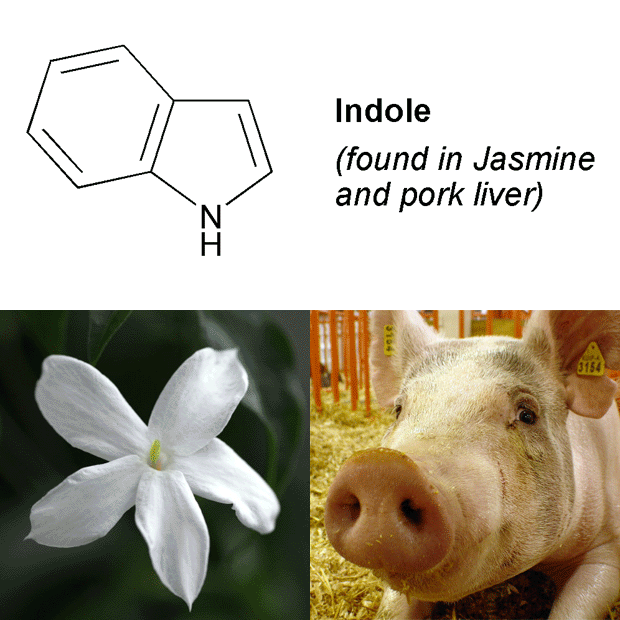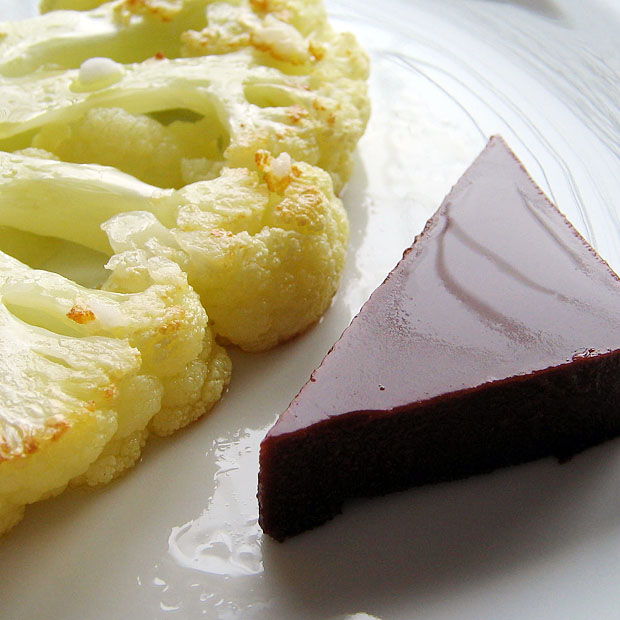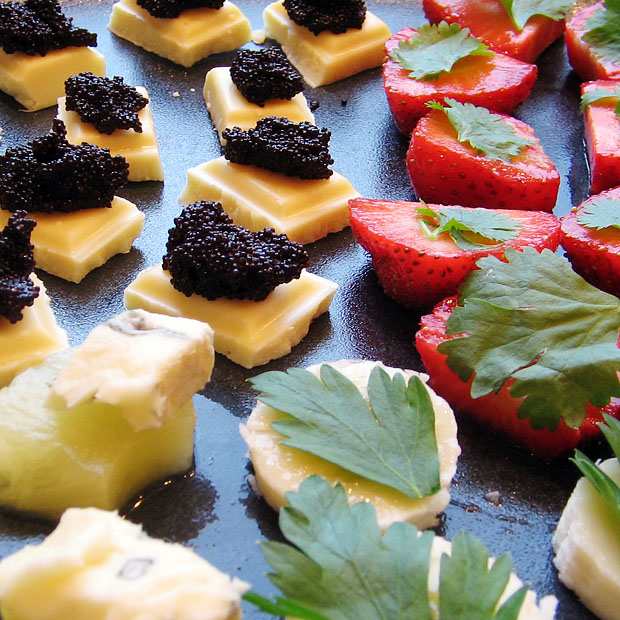When we say that something tastes nice, what we are talking about has more to do with smell than with taste. It is estimated that 20% of a tasting experience comes from taste, that is from the tongue, whereas 80% comes from the smell or the aroma. Our tongue has about 9000 taste buds that are capable of detecting sweet, salt, sour and bitter (in order of increasing sensitivity). In comparison, we have around 5-10 million cells or receptors capable of detecting smell. There are about 1000 different smell receptors and they allow us to distinguish more than 10.000 different smells! This is possible because a specific volatile molecule can trigger more than one receptor. It is the combined response from these receptors that we perceive as a certain smell. The Nobel Prize in medicine for 2004 was awarded to Linda Buck and Richard Axel for their “discoveries of odorant receptors and the organization of the olfactory system”.
Based on the fact that aroma of foods is so important for the way we perceive them, a hypothesis can be put forward: if the major volatile molecules of to foods are the same, they might taste (and smell) nice when eaten together. The concept was first appreciated by Firmenich scientist Franí§ois Benzi. At one the first International workshops on molecular gastronomy in Erice, he got the idea that jasmin and pork liver which both contain indole could possibly work well together. And they did!
 Photo credits: Jasmine flower by B.traeger. Pig by The Pug Father.
Photo credits: Jasmine flower by B.traeger. Pig by The Pug Father.
Experimenting with salty ingredients and chocolate, Heston Blumenthal discovered that caviar and white chocolate are a perfect match. Franí§ois Benzi found that caviar and white chocolate had several amines in common. Since then, Heston Blumenthal has searched a commercial database with information on the contents of more than 7000 volatile molecules in several hundred different foods. Based on this, he has come up with a number of unusual combinations (from egullet.org and other sources). Some of the combinations are also from Herve This. The links are to Heston Blumenthal’s own recipes.
- White chocolate and caviar (trimethylamine)
- Strawberry and coriander
- Strawberry, celery leaves and mint
- Mango and pine extract
- Green peppercorn jelly and beetroot
- Snails and Beetroot (the flavor molecule that contributes to the earthiness in each of these is the same. It also exists in spinach and baby corn)
- Chocolate and pink peppercorn
- Carrot and violet (ionone is the main pairing molecule here)
- Carrot and coriander seeds
- Mango and violet
- Mango and pine
- Pineapple, blue cheese and white wine (methyl hexanoate)
- Caraway and lavender are surprisingly interchangeable
- Cauliflower (caramelized) and cocoa
- Liver and Jasmine (indole)
- Cooked cheese (like Parmesan and Gruyere) and honey (with a slightly chestnut character)
- Banana and parsley
- Banana and cloves
- Harissa (chili paste) and dried apricot
- Chocolate and smoked eel (and possibly other smoked flavours as well?)
- Chocolate and meat (pyrazines)
- Coffee, cooked meat, popcorn, canned tuna, slightly roasted white sesam seeds and yeast extracts (2-furfurylthiol and 2-methyl-3-furanethiol)
Garlic, coffe and chocolate. Garlic and chocolate don’t have much in common, but both have something in common with coffe (original blogpost, cooking challenge: TGRWT #1). - Salmon and licorice
- Oyster and passion fruit (methyl hexanoate)
- Oyster and kiwi (methyl hexanoate)
- Pineapple and hop (methyl hexanoate)
Pairings that possibly/probably have a molecular basis:
- Chocolate and caraway (or: sauerkraut, aquavit etc.)
- Chocolate and sage
- Chocolate and tobacco
- Chocolate, peanut and merlot vinegar
- Chocolate and red wine
- Mint and mustard
- Parsnip, pear and vanilla
- Minced meat and caramel
- Orange and butternut squash
- Apple and lavender
- Onions, cinnamon, olives and caramel
- Cocoa and mushrooms
- Stilton and rhubarb
- Chantarelle and apricot
- Hazelnut and nutmeg
- Honey/caramel and truffles
- Sweet white wine and pea shoots
- Cranberries and pistachio
- Semolina pudding and red curry
- Parmesan mousse
- Olives, dried figs and brie
- Onion, garlic and coffee
- Chestnuts and praline
- Tomato and strawberry
- Aspargus and violet
- Potato, coffee and capers
The flavour pairing principle can also be used for substitutions:
- Basil (containing linalool, estagol and eugenol) can be substituted by a combination of coriander (linalool), estragol (tarragon, chervil or star anise) and cloves (eugenol)
- Try to use coffee in stead of stock for gravies
- Strawberries and tomatoes appear to be interchangeable
To explore flavour pairings like the ones I’ve described on this page, I have initiated a monthly food blogging event, They go really well together (TGRWT), and a summary with links to previous announcements and round-ups has been posted. You also check out my blogposts tagged TGRWT and/or posted in the flavor pairing category.
Databases which can be of interest for investigation of further flavour pairings:
- Volatile Compounds in Food
- Flavornet
- The good scents company – an elegant way to search for volatile compounds shared by two foods is to type the following in a google search box: “pineapple cheese site:http://www.thegoodscentscompany.com”.
- The website foodpairing.be has beautiful graphs depicting both flavor pairing and flavor substitution – highly recommended!

Caramelized cauliflower and cocoa taste excellent when eaten together. It is fascinating how well the aroma of the two go together, and if I smell roasted cauliflower now, the smell actually reminds me of cocoa! Here’s how to make it:
Caramelized cauliflower and chocolate jelly
cauliflower
olive oil
salt
cocoa powder
water
sugar
agar
Cut cauliflower in 1 cm slices. Spread them on aluminum foil. Sprinkle with olive oil and salt. Bake in oven at 200 °C for approx. 30 min (turning the slices after 15 min). For the jelly, bring 1 dL of water to the boiling point. Add 1 ts of agar-agar, 1 ts of sugar and 1 TS of cocoa powder. Mix well, pour into a suitably sized container and leave to set. Cut jelly into pieces and serve together with caramelized cauliflower.
Other examples I have tasted include white chocolate/caviar, strawberry/coriander leafs, pineapple/blue cheese and banana/parsley (see picture below). They all go surprisingly well together, and I guess the challenge for the cooks is to find a suitable way of presenting these dishes. You can read about other bloggers attempts at this in the many TGRWT posts.

White chocolate/caviar (top left), strawberry/coriander leafs (or seeds), pineapple/blue cheese and banana/parsley

Another website that works a bit in this way, with a flavor database is http://www.cuuks.com
It’s interesting for creating new flavor combinations or getting inspiration from others
the website stop working. Are they going to fix the problem?
It’s up again now 😉
[…] to our senses. Martin Lersch (a professional inorganic chemist, by the way) has compiled a list of flavor pairings (some of them intuitive, some of them seemingly odd) on his wonderful blog on […]
[…] Foodpairing.com Blogs about science and cooking: Carbon-footprint foodpairing Sense for taste Khymos Articles about science and cooking: Tech […]
It’s something really interesting! The possibilities of composition (combination) are diverse. I use combinations of these “unexpected” to make my flavors. That is, substances present in different types of food but with the ability to leverage this or that sensory attribute, this or that molecule. Really fantastic!
[…] he dejado patente en lamargarita (y allá donde voy) mis dudas sobre lo que se vino en denominar “Flavor pairing” o maridaje basado en los aromas. Muy en resumen, se trata de una teoría que proviene de algunos […]
[…] http://blog.khymos.org/molecular-gastronomy/flavor-pairing/ Rate this: Share this:ShareLike this:LikeBe the first to like this post. […]
[…] Martin Lersch, Flavor pairing [dostÄ™pne na blogu autora:] Khymos. […]
Pairing you may not have encountered.
Green fig preserve and blue cheese
Kumquat preserve and sharp cheddar
Coffee powder mashed with avocado to produce a delightful nutty spread
Question
Will Sage, lemon and cardamom dance in a lamb roll stuffed with venison?
[…] gevonden! Een blog van een Noor, die scheikundige en kookgek is. Zijn post over Flavor pairing is briljant. Hij presenteert een lange lijst van smaak-combinaties, die hij op werk van mijn grote […]
[…] Check this site out and go crazy: Khymos […]
[…] http://blog.khymos.org/molecular-gastronomy/flavor-pairing/ […]
I think this is a very intrestin page and gives lots of Imformation out.
[…] I thought it’d be worth dropping a few links here for other adventurous cocktail enthusiasts. Khymos has a great page explaining the idea behind choosing foods with a common chemical makeup, and even […]
[…] into some kind of unholy Frankendrink. Speaking of which, all of the drinks in this post use flavor pairings suggested by molecular gastronomists, who analyze the chemical makeup of varios foods’ […]
[…] artykuÅ‚ Dieta pod mikroskopem – era “gastronomii molekularnej”? lub odwiedźcie blog Martina Lerscha. W bazie Foodpairing.com przeważnie znajdujÄ… siÄ™ przepisy ze skÅ‚adnikami nieosiÄ…galnymi dla […]
Wonderful site – thank you for sharing this. I’m massively into cooking, aromas and also cooking.
By being an olive oil taster I discovered the magic world of food pairing and I am coming quite often to consult your blog in order to try unexpected combinations and surprise the newcomers in the world of olive oil excellence.
Fresh ideas, possible to elaborate at any time…Excellent blog! Scientific and easy for a food enthusiast to follow.
I have made the most delicious honey lavendar ice cream and wanted to make a decadent chocolate brownie tart for dessert to pair. Haven’t tried the two together yet but wondered if anyone had an opinion on chocolate and lavendar together?
I saw this link on Coursera.org, and I must say, this is fantastic! Can’t wait to pair the caramelized cauliflower with the cocoa jelly! I can I can learn alot from your blog 🙂
I’m a recent food blogger on http://www.beyondzucchini.com, with a special focus on vegetarian/fish dishes
[…] can find shared odorants in a surprising selection of foods: famously, white chocolate and caviar have the odorant trimethylamine in common, while oysters, […]
[…] Credit to-http://blog.khymos.org/molecular-gastronomy/flavor-pairing/#sthash.EpPHJVD5.dpuf […]
Great post. I had previously relied on the Flavor Bible for pairings, so thanks for the link to http://www.foodpairing.be
[…] http://blog.khymos.org/molecular-gastronomy/flavor-pairing/ […]
[…] Fuente|http://blog.khymos.org […]
Love this! …And for those of us who don’t know all the molecules; what a fantastic pointer that actually if two ingredients smell fantastic together, they may well be a perfect taste match too!
What are two flavors which taste bad alone but great together?
I can’t immediately think of any obvious real examples. Something like vinegar probably doesn’t taste good to you by itself, but you’d find they make great additions to salad dressing. Most people aren’t fond of the flavor of raw onions, but they a…
[…] eaten together. What may seem like an impossible pairings can actually be a perfect compliment. Click here is you want to read more on food […]
[…] defies conventional sensibilities, you know that the secret lies in the underlying chemistry. Have a go at home – we especially recommend trying chocolate and blue cheese – both have 73 […]
[…] Credit to- Khymos.org […]
[…] would be the ultimate foodie exploration meal. If you want to learn more check out Food Pairing and Khymos. The food pairings explored […]
[…] eaten together. What may seem like an impossible pairings can actually be a perfect compliment. Click here is you want to read more on food […]
Those are not jasmine flowers next to the piggy. Those are mock orange flowers.
Thanks for pointing out the mistake – the picture has been updated!
tangerine-tahini-a little salt